(résumé en français en bas de page)
[ last update: 05.13.2014]
The (new) Cadillac Database©
The Cadillac
Vee-Sixteen
1934-1937
Part 4a
A story about a 1937 Roadster
by Hartmann of Lausanne, Switzerland
Return to The (New)
Cadillac Database© Index Page
or return to the "Miscellaneous Cadillac Stuff" index
page
or go back to the V-16 index page
Unless otherwise specified all photos
and illustrations are from Yann Saunders'
collection of Cadillac photos, advertisements and product catalogs,
reproduced courtesy of the Cadillac Motor Car Division and the Cadillac-LaSalle
Club, Inc.
(résumé en français en bas de page)
In 1937 Cadillac built only two convertible coupes on the sixteen-cylinder chassis, type 37-90. The incredible roadster described in these pages was built on one of only two V-16 chassis/engine units released by Cadillac to independent coach builders that year. The engine is #5130328, identifying the car as the twenty-eighth out of a mere fifty V-16 units built that year.
The chassis was ordered from Detroit through the Edelweiss Garage - being the local Cadillac dealer in Lausanne, Switzerland - by Philippe Barraud, son of a wealthy businessman who had "built" his fortune in bricks and roofing tiles.
Abandoned by its owner in the mid-sixties and found - aged 31 and derelict - in a field, about 10 miles from my former home, in the summer of 1968, it was acquired shortly thereafter by the second owner for just 4000 Swiss francs (the equivalent, at that time, of approximately $925).
To my knowledge, it has changed hands about six times since then and has been frequently [and deliberately?] advertised - falsely - as being a unique creation by Figoni & Falaschi.
Restored three times (once too many, in my opinion) and owing to the false Figoni & Falaschi label, the alleged value of the Hartmann roadster has soared out of all reasonable proportion, multiplying more than three-thousand-five-hundred times in just twenty years.
As I said above, the Hartmann car was sold in the late sixties for just under $1,000. Since then I have seen it advertised by Tom Barrett III for $1'000'000, [October, 1987], $1,250,000 [April, 1987], $2,500,000 [April, 1989] and even $3'500'000 [date not recorded but I still have a copy of the ad]!According to the most recent information at my disposal, the Hartmann V-16 was acquired by Ken Behring, in January 1990, at Scottsdale, AZ, for the Blackhawk collection, for a "mere" $1.4 million...
*** This is the true story of that preposterous automobile ***
In Search of a Car - In Search of a Dream
In August 1937, near Lausanne, in Switzerland, a young man was snapped beside the car of which he had just taken delivery. It was a "monumental", special-bodied 1937 Cadillac V-16 roadster. The youthful owner’s name was Philippe Barraud. He was a dashing and wealthy young playboy in the thirties. In his youth, he had as many cars as he could care for. Money was no object. But there were other young men from wealthy families that lived along the fashionable Swiss Riviera that stretches between Lausanne and Montreux on the shores of Lake Geneva. What kind of car could Philippe possibly buy that would put to shame all their fancy Delahayes, Delages, Talbot-Lagos and other flashy sports cars?
Philippe Barraud, his car, his Jack Daniel dog in Switzerland, August 1937; on the body sill, to the right of the dog, you can see the coach-builder's nameplate;
I assume it read simply "Hartmann"; fuzzy image at far right shows detail of RH ['36 Chevy ?] tail light with a fixture for the oval, country ID plate and the "acorn" turn signal lamp
below it; a similar light fixture was mounted on the left and carried the Swiss vaudois license tag "VD 2264"; both plates were illuminated from the top of the tail-light pod
[ Photo: © 1937, Bouboule, Lausanne, CH ]
In the RH photo you can almost make out the shape and the extremely modest
dimensions of the two-bar rear bumper, in the style favored by Figoni & Falaschi
[ all sepia-colored shots in this section are by Mr. Luthard, aka Bouboule, August 1937 ]

Note: the original parking lights installed on this car are regular Chevrolet parts for
the years 1937-1939; I only realized this when I came across a pair (above) for sale on Ebay, in 2009
This is believed to be the type of tail-light used originally
on the Hartmann car; it is a Chevrolet model from 1936
[ Photo: Ebay, 2009 ]
One day in the latter part of 1936 Philippe had visited the Edelweiss Garage, on Avenue de Morges, in Lausanne. This was the showroom of the local Cadillac dealer. There he picked up the latest Fleetwood sales portfolio. Two V-16 models were illustrated: a sober limousine, Fleetwood style #5875, and a dashing convertible sedan, Fleetwood style #5880. Both were built on the longest ever production Cadillac chassis, with an incredible 154-inch wheel base.
Now HERE was a car of imposing proportions! Philippe could readily imagine how puny a Delahaye or a Hispano-Suiza would look parked next to it! He inquired of the Cadillac dealer if it might be possible to order only the chassis and then to have a body of his own choice built on it. He was told this would pose no problem whatsoever.
Philippe could have chosen any one of a dozen independent and popular coach builders of the time (Franay, Million-Guiet, Vizcaya, Letourneur and Marchand, Van den Plas or even Figoni & Falaschi). But like all young men he was impatient. He had to have his new toy quickly. And he had to have it built close to home so he could supervise the work and keep a close check every day on the progress being made.
There were a few independent coach builders in Switzerland in the late thirties but only one in the immediate vicinity of the Barraud home in Bussigny, above Morges. His name was Willy Hartmann. His workshop was located only a few miles away, in the Laborde area of Lausanne.
Willy had earned a reputation "customizing" stock European models like the Opel and Ballot. In 1932, he had built also a prize-winning convertible on a Isotta-Fraschini chassis for the Countess of Varax. All in all he built around fifty car bodies between 1928 and 1939; after that he worked only on specialty vehicles for the Swiss armed forces. When I spoke to him in 1987, Willy said that he had burned most of his records after WW2 "to make room for more projects"!
So Philippe went to Hartmann and asked the young customizer if he would design and build for him something really exceptional and glamorous on the Cadillac V-16 chassis.
Hartmann drew a few sketches. Philippe immediately set his heart on a streamlined roadster proposal featuring fully enclosed fenders front and rear.
The Influence of Erdmann & Rossi
Streamlined designs like the one drawn by Hartmann had been seen first at the Barcelona [Spain] and Berlin [Germany] Motor Shows, in 1935. On the stand of Erdmann [almost a phoneme of Hartmann] and Rossi were two such streamlined convertibles: a 2.9-liter Mercedes and an Opel, both featuring fully enclosed fenders, front and rear. Later that year the German company was commissioned to build an almost identical body on a turbo-charged, 5.4-liter Mercedes 540K [order #2698 of 5 December 1935, engine #123705] for no less a client than King Ghazi of Iraq1.
In 1933, at the age of 21, Ghazi had succeeded his father on the throne. Unfortunately, the reign of the young king was short-lived; he died in a motoring accident only six years later in 1939. It is not known what car he was driving at the time.
King Ghazi of Iraq, as a young fighter pilot

(Right) The 2.9 liter Opel cabriolet; (left) the 5.4 liter Mercedes 540KIf the Mercedes 540K that I saw in Baghdad, Iraq, in March, 1983,
has perchance survibed1 the last two Iraqi wars, in my opinion, it is worth between 3 and 5 million
dollars today (2012); note the huge overhang from the radiator front to the headlights

As seen in France's "La Vie de l'Auto" for 1 Nov. 2001 ( p.22), this fabulous car
participated in the 13th Monte Carlo "Old Timer" Rally, from 15-23 Sept. 2001
King Ghazi's custom Mercedes 540K on display in Germany, in 2007-08 (?)
King Ghazi’s car had single headlights as opposed to the stacked pair on the German Motor Show car. On completion of the body by Erdmann & Rossi, the car, designated as a Sport Cabriolet, was delivered to the Daimler Benz headquarters for onward shipment to their illustrious client.
I was privileged to see that incredible machine and even to photograph it through the dusty showroom-type window of a small, heavily-guarded but derelict auto museum in Baghdad’s Fawzah park, in 1983, shortly after hostilities broke out with Iran. The Mercedes was one of sixteen old cars of state, some of which once had belonged to the royal family. It was painted cream with dark green accents.
I am told the photos below were taken in a Baghdad underground garage following the U.S.'s "Shock & Awe" attack on the city in March 2003. This information does not tie in fully with what I was told in 2002 [see footnote1, below].
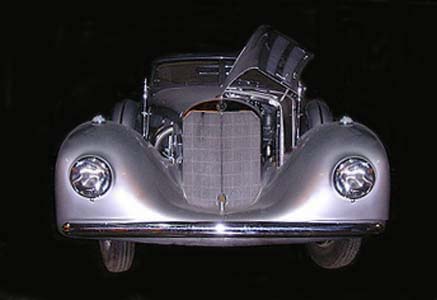
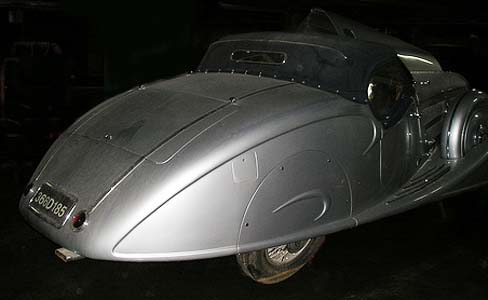

The license tag in the center photo differs from the tag seen on the car in Germany, in 2007/08
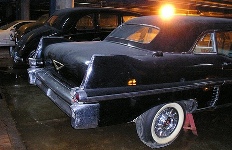

I believe the cars in the above two rows are the same ones of which I took pics in Baghdad in March, 1983;
the marks on the lower part of the tires suggest the cars may have sat for some time in muddy water
________________________________________
1 Late Extra: I found out in January 2002, that King Ghazi's car had miraculously survived. Here is an excerpt from an article about Erdmann & Rossi's design chief, Johannes Beeskow, entitled:
Mercedes-Benz 5,4 Liter Kompressor 1935, all rights and © by: ArTeG]Mercedes commissioned a show car from us [Erdmann & Rossi] for the 1935 Barcelona exhibition. One of the visitors was the King of Iraq. He expressed his desire to buy the car but the Mercedes people said he could not have it because it was only powered by a 2.9 liter engine; however, they added that he could have an identical car powered by the 5.4 liter motor with compressor [the renowned 540K]. The King accepted their offer and so we rebuilt the same car but with the 5.4 liter engine. The King's coat of arms was painted on the doors before it was shipped to Iraq. The car was still there, in a museum, in the seventies [CORRECT - I saw it there and photographed it in March, 1983. When the Gulf war broke out (1990-1991), I thought to myself there can be nothing left of the car now. To my great astonishment the car surfaced again; in the interim, it had gone to Jordan, at a time when the two countries were on friendly terms. King Hussein of Jordan, an auto buff, had it stripped of its paint then shipped to Germany in 1986 for a full restoration. In 2002 (i.e. before the U.S. "Shock & Awe" campaign of March 2003), the car was believed to be back in Jordan, looking just as it did back in 1935. In 2008, Oliver Kossatz, an admirer of the Hartmann car, told me that King Ghazi's custom Mercedes 540K was on display at a classic car dealership in Berlin].
...and that of Figoni & Falaschi
In the footsteps of Germany’s Erdmann & Rossi, France’s "Italian" duo, Figoni & Falaschi, also were among early exponents of fully enclosed fenders. Their prize-winning design on the Type 165, 12-cylinder Delahaye for the 1937 Paris Salon featured the same boomerang motif on the enclosed fenders as had been seen two years earlier on the German cars.
Giuseppe Figoni, an Italian emigrant - who changed his name to Joseph after he settled in France - had entered into partnership with another Italian, Ovidio Falaschi, in 1935. The Delahaye 135MS roadster they built for the Paris Salon of October 1936, based on a drawing by automobile artiste Geo Ham, brought the pair early renown. There had been some legal wrangling about the design until it was agreed that the cars (11 of them, including the Paris show car) would carry two "designer labels" [body plates], those of F&F and that of Geo Ham. Ham was born George Hamel in 1900 and acquired early fame as an artist by drawing catalog illustrations for a small airplane builder and, subsequently, action-filled scenes from Paris' Montlhéry automobile race track.
It has frequently been rumored - and you can see why - that Hartmann was inspired by the F&F design [check the illustrations, below, of the Paris Salon car and a couple of survivors among the 11 units built; see also TQ 1-2/84, pp.16-17 and The Classic Car, summer 2006, pp. 20-21].
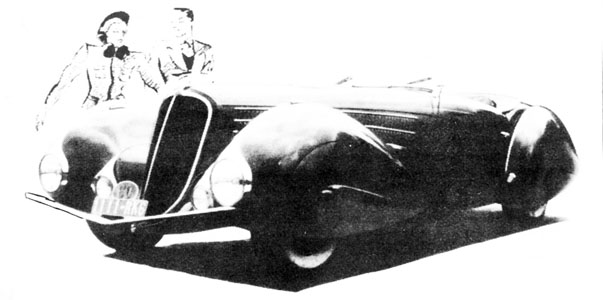
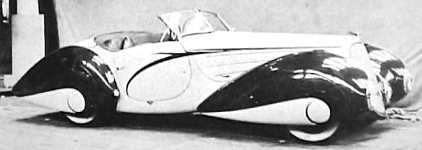

The original 1936 Paris Salon Delahaye that was
acquired on the opening day by the Aga Khan
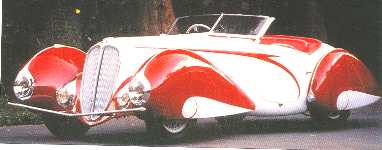
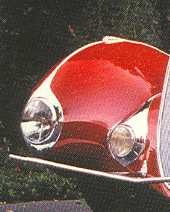
Eleven of these streamlined Delahaye 135 roadsters
were built by Figoni & Falaschi,
this is one of them; note the paired, tear-drop lights (detail, right); it is believed
only three have
survived; this is not the Paris Salon/Aga Khan car; it was bought originally by an
Austrian
diplomat; today it belongs to Delahaye enthusiast, Jacques Hargindeguy in the USA
For the historical record, the F&F Delahaye said to have inspired Hartmann was purchased on the opening day of the Paris Salon, in 1936, for 150’000 French francs, by the Aga Khan III, spiritual leader (from 1885 until his death in 1957) of the Ishmaelite sect of the world’s Moslem (Muslim) population. In 1936, Aly Khan (his down-to-earth name) literally was worth his weight in gold. Indeed, in the course of decennial celebrations, begun in 1936, his followers would "pay" their respects by showering on him his own weight in precious metals and stones; in 1936 it had been gold, in 1946 diamonds and in 1954 platinum!
In these conditions, the Aga Khan could well afford to buy the Delahaye and to have the French coach-builders fit stronger bumpers as well as repaint and re-upholster the flamboyant automobile a less ostentatious color. He chose burgundy red.
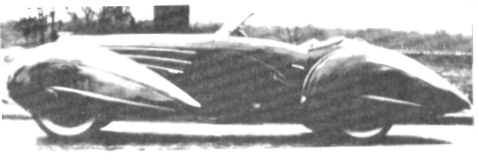
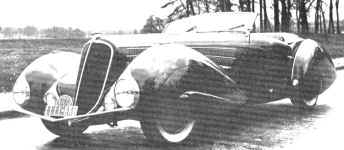
As acquired (and repainted maroon) by the Aga Khan,
soon after the Paris Salon
Another, similar (identical?) Delahaye found its way to the USA where it was owned for some time, before and after WW2, by the late Bob Grier, a member [President?] of the now defunct Sports Car Club of New York. I have a photo showing that the original color scheme was reversed at one time and that the car was fitted also with a very ornate but delicate front bumper. This one is owned today by American, Malcolm Pray
Another F&F streamlined roadster after a first restoration in the USA

[ Photos: © 2005 and courtesy Malcolm Pray and CCCA ]
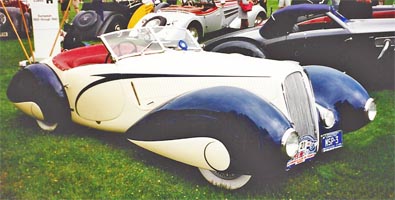
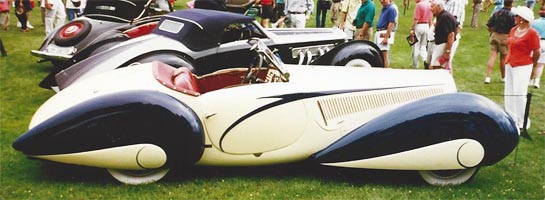
Today (2006) it belongs to Malcolm Pray, also in the
USA, who got it in 1964 from Long Island, NY. F&F expert, Richard Adatto,
and French historian André Vaucourt don't believe this to be the Salon car either;
it may be the one shown at the NY World's Fair,
although that assumption has not been effectively documented. This is the car owned
later by Bob Grier of the Sports Car Club
of New York; the bumperless survivor left) and the (same?) car (right)
resemble closely the original 1936 Paris Salon Delahaye
[ Photos: © 2005 Ron VanGelderen, CLC ]
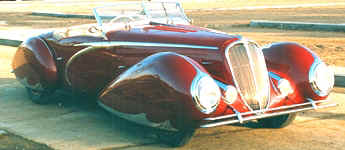
This replica body was mounted on chassis #800220 by Peter Agg (UK) ;
I believe the rear bumper on the Hartmann car was similar to this F&F front
bumper
In those days, everyone seemed to be copying everyone else. The great Harley Earl himself is said to have borrowed heavily from European marques such as the Hispano-Suiza and Isotta-Fraschini when he created the beautiful LaSalle in 1927. Hartmann was no exception. His design for the 1937 Cadillac V-16 could be considered as an upsized replica of a roadster designed by Figoni & Falaschi on the 6-cylinder Delahaye Type 135 for the 1936 Paris Salon.
Yes, in those days, what would result today in a lawsuit alleging infringement of copyright, was merely fair game. There were no ill feelings on either side. In fact, the Franco-Italian duo pulled a similar fast one on Hartmann, two years later, by borrowing from him for another of their creations on the Type 135M Delahaye chassis, the broad body stripe which the Swiss coach-builder had used on the Cadillac V-16.
Here is a Delage D8-120 bodied by De Villars with that same central rear fin treatment
[ Photo: the late Dave Holls' collection ]. Paris' Henri Chapron used the same central
fin design on a 1939 Delahaye MS135
F&F borrowed Hartmann's curved "V" body stripe on this Delahaye 135M
convertible coupe they built in 1939-40. Anyone who has viewed an F&F body close-up
will agree that bumpers were not their "strong" points (no pun intended)
The Czech coach builder, Sodomka, mounted this streamlined
coupe body on the Aero 50 chassis; look at those wheel skirt designs!
Hartmann Dresses a Cadillac
Philippe’s V-16 chassis arrived in Lausanne in April 1937 by rail from the GM facilities in Antwerp, Belgium. Work on the roadster body began immediately. It was completed in the Fall. The basic Cadillac components used were the chassis, engine and firewall. Hartmann retained also the banjo steering wheel (used on Cadillac models that year for the first time), the dash instrumentation and the "V-16" emblem which he mounted at the top, RH side of the modified radiator grille. The glove compartment was deleted and the instruments relocated from the left of the dashboard to the center. The positions of the clock and speedometer were reversed so as to place the speedometer closer to the driver. The radio was moved to the LH side of the instrument board and placed directly in front of the driver. The ash-receiver, with its winged-emblem on the lid, was omitted also to make room for the rear-view mirror. The triangular "Cadillac" badge located between the radio knobs on stock 1937 Cadillac models was redesigned and moved to the far right of the panel. It carried the Cadillac crest at the top and the words "Carrosserie Hartmann, Lausanne, Cadillac" (see sketches, below). In shape and size, this dash plaque is very similar to the one used on Cadillac-LaSalle models of the same period.
Above, left: the standard instrument panel badge found on the La Salle models of 1937;
Above, right: the modified instrument panel badge on the 1937 roadster by Hartmann
[ These two drawings: © 1983, Yann Saunders ]
Other changes to the dash panel included the ignition switch being moved from its regular position in the center of the panel, below the radio, to the left of it, thus locating it closer to the driver. Some knobs and controls (like the cat's eye lighter and map light) located on either side of the ignition key on stock Cadillac models of 1934-1937, were moved to right and left of the instrument board. A turn-signal indicator switch was added on the left of the dash.
I have found no early (1937) photos of the modified dash; the earliest ones are those I took at the home of the third owner in the fall of 1973. I assume the dash configuration at that time was the same as adopted by Willy Hartmann in 1937.
Just like the Figoni & Falaschi Delahaye built for the 1936 Paris show, the V-16 roadster was painted off-white with a broad, contrasting orange body stripe. The fully-enclosed fender skirts, front and rear, featured an ornate and raised panel painted the same color as the body stripe.
First Registration
The Cadillac was presented to the Swiss licensing authorities for inspection on 25 August 1937. There was some doubt as to whether it could be registered as a private automobile owing to its sheer size. It was some 22 feet long ! It took some convincing on the part of both the owner and the coach-builder to have the authorities agree that the Cadillac was in fact a passenger car and NOT a truck.
Finally the car was issued the certificate of conformity and got its first set of license plates (tags) #VD2264.
Later that same afternoon, Philippe first drove his new "toy" to all the fashionable haunts around Lausanne. Naturally, the car caused quite a stir.
Early Photos
The earliest photos of the Hartmann car were taken in the Fall of 1937 by a local Swiss press photographer nicknamed Bouboule (the "little ball") on account of his short, chubby build. Mr. Luthard (Bouboule’s real name) took the pictures near the Barraud home in Bussigny-sur-Morges, soon after the Cadillac had been delivered to its proud new owner.
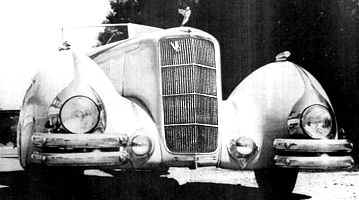
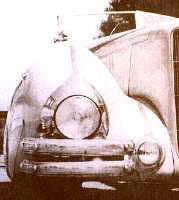

Left: the original Hartmann front clip, with
bumperettes and inboard, tear-drop road lights; these were omitted
during the various, subsequent restorations (if I owned the car, I
certainly would want to make it as original as possible again)
[ Photos: © 1937, Bouboule ]
Sadly, Bouboule passed away in the seventies. Mr. Baumgartner, his successor in Pully, near Lausanne, tells me that his daughter disposed of all her father’s belongings (including the contents of the photographic studio), shortly after his death. Hence, all the original photos and negatives were either lost or destroyed.
Gigantic... but nevertheless graceful!
[ Photo: © 1937, Bouboule ]
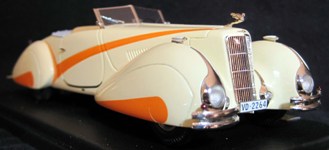

We have no color photos of the car when it was new; this is a 1:43 scale model of the car,
built by EMC in the Ukraine, in 2009, based on photos and descriptions I sent the makers
Spring Returns - Repaint #1
Philippe used the car regularly for the next two years until war broke out in Europe, in September 1939. Thereafter, and late into the forties, it became increasingly difficult, even when one had plenty of money, to find gasoline in Switzerland for a thirsty, sixteen-cylinder automobile. And so the huge Cadillac roadster was laid up for the next almost ten years.
In the Spring of 1949 a young man’s fancy turned again to thoughts of... a huge Cadillac roadster, lying under inches of dust in the family coach-house. Philippe took the car out into the sunshine. It looked shoddy from the years of neglect and the thick coating of dust. He decided to have it repainted. He retained the original color for the body but changed the color of the broad, lateral stripe and the fender skirt panels from bright orange to pale-blue. According to copies of related documents in my possession, the car was licensed again from April 21, 1949. The new tags were: VD19044.

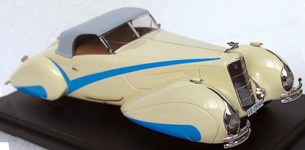
Again, in the absence of color photos of the actual car, in 1949, this is a good guess as to what it looked like after the first repaint
and new registration; thanks again to EMC in Ukraine for this 2nd version of a very beautiful sixteen-cylinder convertible roadster
The V-16 had been plagued with overheating problems and its owner decided to accept the suggestions of a mechanic friend and to have two additional vent doors installed horizontally on either side of the grille shroud.
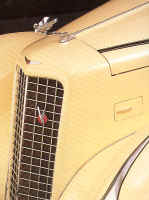
You can see the new hood vent in the closed
position (left) and open position (right)
Philippe used the Cadillac only sporadically over the next 10 years. Many new and more modern automobiles had taken its place at the Barraud home. In fact, the gigantic Cadillac had had to be moved to another storage location some distance from the Barraud home to make room for the newer cars.
Repaint #2
In the mid-fifties, following a collision in which the front of the car suffered considerable damage, Philippe had the V-16 repaired and repainted for the second time. This time he chose a light, (Swiss?) milk-chocolate color for the body, while the wide lateral stripe and lower fender skirts were repainted a dark brown hue.
The specially cast tear-drop inner road lights had been all but destroyed in the collision. Their remains were discarded and new, bullet-shaped headlight units initially designed for a smaller, European car were purchased off-the-shelf and mounted on specially-made brackets on either side of the grille housing. These were painted to match the stripe and lower body color. New, hexagonal-section Batain-type bumpers were installed front and rear; parts from the original bumperettes were used as impact guards.
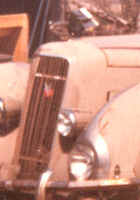
"Bullet" road lamps replaced the graceful, tear-drop kind; remains of initial
bumperettes appear to have been used as impact guards on the new, Batain bumpers
The Car Goes into Storage Again
Philippe stopped using the car altogether in the early sixties. It lay idle in the Eichenberger warehouses in Ouchy, down by Lake Geneva. Owing to preparations being made for the EXPO SUISSE (the Swiss National Exhibition of 1964), Philippe was asked one day, in late 1963, to move the Cadillac out of the warehouse where it was taking up precious room needed for exhibition props.
The Cadillac had begun to show signs of age. Philippe realized also that the storage bills he was having to pay each month were completely out of proportion with the market value of the car at that time. He decided to place it in the care of a mechanic friend by the name of Marcel Blaser who ran a used-car lot in the village of Gilly, in the Jura foothills, about 10 miles from the Barraud home [and from our home in Geneva at the time].

The "milk-chocolate" roadster in Blaser's yard at Gilly, in Switzerland
(note in this photo the new styled road lights and bumpers that use parts
from the original bumperettes as impact guards.
[ Both photos: © 1968 and courtesy J.-J. Belet ]
News of the presence of the strange-looking roadster soon got around and Mr. Blaser started to be harassed by many callers, amateur photographers and just plain inquisitive passers-by who wanted to know everything there was to know about the huge and exceptional roadster.
Mr. Blaser kept the car on his lot in Vinzel, a small but charming village located a stone’s throw from Gilly and overlooking Lake Geneva.
The Second Owner
The Hartmann V-16 was re-discovered in the summer of 1968 by Mr. Jean-Jacques Belet, a member of the Veteran Car Club of French-speaking Switzerland (the VCCR). By that time the replacement road lights had disappeared, although the support stanchions still remained in position.
What was amazing was that the ornate "V-16" grille medallion should have escaped for so long the nimble-fingers of the many car buffs who must have eyed it with envy!
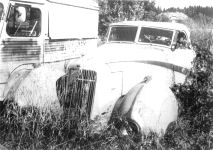
This is how the V-16 looked when Jean-Jacques Belet bought it in
April 1969; even the interior was "over"grown by "under"growth
[ Both photos: © 1969 and courtesy J.-J. Belet ]
Some twenty years later, while Gita and I were walking the dog, after a tasty meal of Malakoffs in Vinzel, we chanced upon the very spot where the Hartmann V-16 had lain, sadly neglected, for five years. I suddenly realized that the traditional Swiss farmhouse we were admiring, in the distance, and the woods behind it (identified as the Bois de Beaulieu), was exactly the house in the background of an early photo I had of the Hartmann car [B&W photo, above, left].

Chatting to some of the local village folk I was able to glean more information about Marcel Blaser (who, they said, had died in the early seventies) and about Mr. Belet, whom I learned had bought the car from Blaser in 1969.
The V-16 is Saved
Back in the summer of 1968, when Mr. Belet realized that the car was a Cadillac and that furthermore it was powered by an engine with 16 cylinders, he recognized immediately that despite its poor condition (it had lain outside for five years with a damaged canvas top), it was definitely a collector’s item worth buying and attempting to restore. He made inquiries about the possibility of finding the spare parts that might be needed for its restoration then returned to Gilly in early 1969 to talk business with Mr. Blaser.
How could the latter possibly refuse Belet's offer of 4000 Swiss francs ($925 at the time) for what he (Blaser) considered to be just another old, second-hand car in very poor condition and - in his opinion - worth no more than $200? So, the car changed hands on February 4,1969. Mr. Blaser handed Mr. Belet a scribbled receipt in exchange for four, crisp, new, one-thousand franc bills (the highest denomination among Swiss bank notes).
Although he was not the rightful owner, Blaser was convinced that Philippe Barraud would be pleased to learn that the Cadillac had been sold and that it had commanded such a "high" price!
It must be remembered that old American cars came cheap in Europe in the late sixties. They had not yet acquired collector status. No rational-minded motorist would have wished ever to own (even less to BUY) one ...except Cadillac-crazy me, perhaps [I remember buying my first car at Xmas 1966 for the equivalent of just under $390! It was a beautiful and nice-running 1956 Cadillac Sedan de Ville; remember that gorgeous 1956 ad The Xmas they'll never forget ? Certainly it was a Xmas I have never forgotten!]
It turned out, nevertheless, that Philippe was very upset that the car had been sold without his prior consent. So upset was he, in fact, that he filed suit against both the vendor (Blaser) and the buyer (Belet). In the ensuing legal battle, both parties claimed they had acted in good faith. The car was old and in visibly poor condition. The owner had neglected it for years. Mr. Belet had made what Blaser considered to be a very reasonable offer for the car and so he (Blaser) had not hesitated to sell it.
When I talked with Mr. Belet in 1987, he showed me copies of correspondence exchanged with Mr. Barraud’s lawyer. The latter contended it was common knowledge that his client had had no intention of ever selling the Cadillac. He had been approached often but had refused consistently all offers ever made for the car. The case went to court. I have a copy of the subpoena issued to Mr. Belet, requiring him to appear at the Courthouse in Rolle, Switzerland, on October 16, 1969. The judge found that there were no reasonable grounds for prosecution. The case was dismissed and Mr. Belet was allowed to keep the car.
First Major Restoration
He told me how difficult it had been for him to retrieve the Cadillac from the undergrowth that had engulfed it. A jungle of wild shrubs and bramble bushes held the V-16 a prisoner in their prickly grasp.
Mr. Belet, who owns a Mitsubishi franchise and body repair shop in Mont-sur-Lausanne, began restoration work almost immediately. He entrusted the delicate task to one of his young apprentice mechanics. Unfortunately, he was not able to obtain any pictures of the car when it was new [Mr. Barraud was so infuriated about losing the court case - and the car - that he refused to give Belet any information about it]. So the restoration work had to proceed by sheer guesswork. Mr. Belet did not know, for example, that Barraud had damaged severely the front and rear bumpers early in the car’s life. The latter had been unable to stand up to frequent bashing against various stationary obstacles which must have been almost invisible beyond the car's very long hood and tapering rear section. He had had to replace the flimsy original bumpers with stronger, hexagonal-section steel bars much like the French, Batain type consisting of a single rhombic (diamond)-section welded steel bar.
The debris from the original bumpers were used as over-riders for the new unit. These over-riders too had been destroyed long before restoration work began in 1969. Indeed, Philippe also had given the new bumpers a rough time with his own particular style of touch-and-go driving. Not only had the original front, tiered half-bumpers (or bumperettes) been destroyed after a rather more severe collision, but also the tear-drop road lights mounted inboard of the huge front fenders had been smashed and put out of commission for good. Philippe realized it would have been very costly to have Hartmann manufacture a new pair of to match the unique tear-drop units cast specially for the Cadillac, back in 1937, so he simply had them replaced with a pair of bullet-shaped headlights off a smaller, European car.
During this initial restoration/repair work, the grille was probably dismantled and repaired too. On rebuilding it, the "V-16" medallion was repositioned on the LH side of the grille, and much lower down.
Non-Original Front Ensemble
By 1968, there was little left also of the original front clip. The original grille had consisted of three horizontal and thirty-one vertical bars; a new "egg-crate" unit was made up from the remaining debris. The "V-16" medallion remained in the new position in which it had been placed after the major repairs done to the car in the early sixties. The resulting front ensemble lost much of the dignity of the original Hartmann design. It began to look more like a traditional Cadillac egg-crate grille.
Also missing were the Hartmann nameplates, located originally on the sill plate below each door. These had been removed and not replaced when the Cadillac was repainted by Barraud for the second time.
Rebirth
The first major restoration was completed by the second owner, Mr. Belet, in the spring of 1970. Round, red reflectors were added above the rear bumper. Also removed were the stanchions above the LH and RH tail lights. The one on the left had carried the car's rear license plate while that on the right bore the acronym "CH", which is the country code for Switzerland [from the Latin, Confaederatio Helvetica, the Helvetic (i.e. Swiss) Confederation].


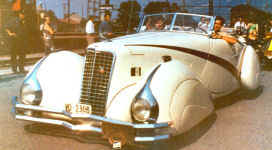
Top: restoration of the Hartmann V-16 nears
completion in spring 1970
Above: outing of the Veteran Car Club of French-Speaking
Switzerland, 7/1970
[ Photos: © 1970, courtesy J.-J. Belet ]
Mr. Belet pointed out to me, in 1987, the poor workmanship that had gone into building this otherwise exceptional automobile. Only when the body was removed from the frame during restoration did he discover what kind of a "Mickey-Mouse" job Hartmann had done of building it.
Between 1970 and 1972, Mr. Belet used the car only occasionally for outings of the Swiss Veteran Car Club. Some photos of the car were taken during one of these outings by Mr. G.N.Georgano, Head Librarian of the National Motor Museum in Beaulieu, England. Two of them appeared in the readers’ column of Special Interest Autos No 2 (February, 1982) where, incidentally, the Cadillac was described - in error - as a 1935 model.
The Third Owner
It was on the occasion of such an outing that Jean-Jacques Belet met fellow car-collector, Patrice De Witte, from France. Patrice had turned up at the meet in a superb Hispano-Suiza. Each of the two auto enthusiasts had fallen for the car of the other. By the day's end, the pair had agreed to exchange their cars. The trade took place in the early summer, 1972 and the Cadillac was driven the 100 or so miles from Lausanne, in Switzerland, to Mâcon, in France, by the young mechanic who had restored it.
Mr. De Witte owned a stately home (....needing major repairs!), called the Château de Montvaillant, located some 20 miles west of Mâcon, where he kept an interesting collection of British classic and French antique vehicles in various hangars, garages and other storage premises in the vicinity of the château.
Picking up the Trail
It was about this time that I picked up the trail of the car through both Eddy Strebel, an acquaintance and journalist for the Swiss weekly Automobil Revue, and Christian Vaney, a young admirer of Cadillac automobiles who had not hesitated to ride his "moped" (a 15-mph motor-bicycle) 100 miles just to have a closer look at this fantastic car!
I made the trip to Mâcon/Clermain more comfortably, in my VW Variant station-wagon, in the fall of 1973. Needless to say, during this initial visit, I photographed the Cadillac from every possible angle.
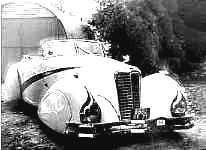
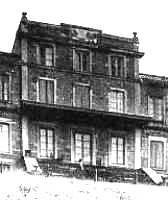
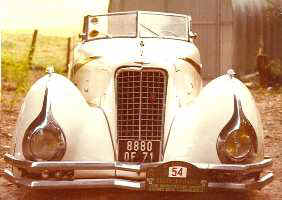

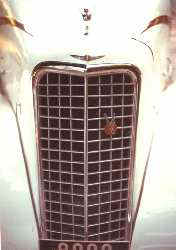

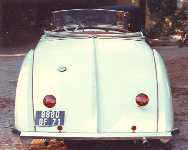
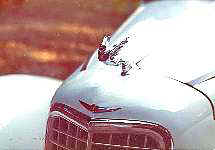
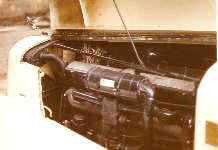
Left: the V-16 roadster looked like this when I saw it for the first time in 1973;
center: Chateau de Montvaillant in France, home of the late Patrice DeWitte;
Right: beautiful, bulbous front fenders of the Hartmann V-16
[ All three photos: © 1973, Yann Saunders ]

Three rare views of the Hartmann roadster with the "shower top" partly installed
[ Mâcon, 1974 - © 1974, Ron VanGelderen ]
Again in Mâcon, France
[ cropped photo: © 1974, Ron VanGelderen ]
News of the Special V-16 Leaks to the USA
The snap-shots I took in Mâcon [above], and a short article about this V-16, were published later in the Self-Starter, monthly newsletter of the Cadillac-LaSalle Club, Inc. (February, 1974). They were reprinted, later, in Torque, the magazine of the Michigan Region Classic Car Club of America (July-August, 1974), and a third time in Antique Automobile, the magazine of the Antique Automobile Club of America (March-April, 1975). Two of my pictures were used also in Roy Schneider's authoritative book, Sixteen-Cylinder Motor Cars.
The story and pictures of the Hartmann car aroused considerable interest in the United States. As a result, I made many new friends among Cadillac enthusiasts in America. Some of them flew specially to Switzerland just to have a closer look at the rare V-16. Among them were Ron Van Gelderen, twice President of the Cadillac-LaSalle Club, Inc., Jack Tallman, a well-known Cadillac dealer and collector of Decatur, IL, one of the founder members of the CLC (he visited with his wife Marilyn and two daughters, Jill & Joy, in the summer of 1974), and Ray and Dorothy Radford of the Classic Car Club of America.
Straight from the Source
Much of the story material in these pages was still missing in 1973. At that time, I was sure that both Philippe Barraud (the first owner) and Willy Hartmann (the coach-builder) had passed away long ago. I was pleasantly surprised, therefore, to find out, in mid-1987, that both gentlemen were still alive and in good health. I was fortunate to be able to talk to both of them and to obtain from the source, so to speak, the real facts about this exceptional roadster and to dispel once and for all the various myths that surround it.
When asked what the special V-16 roadster had cost, neither Philippe nor Willy could remember exact prices although both of them put forward from memory the approximate figures of 30,000 Swiss francs for the chassis (around $6000 in the late thirties) and 12,000 francs more for the body (circa $2400).
Was Hartmann First?
Willy Hartmann had gained recognition four years earlier with a prize-winning phaeton design on an Isotta-Fraschini chassis. So, despite the fact that the Delahaye was on display at the Paris Salon, in October 1936, two or three months before work was begun on the 1937 Cadillac V-16, Hartmann insisted that the likeness between the two cars is pure coincidence. If anyone could claim to have been wronged in the deal, Geo Ham is that person. nevertheless, in my opinion, considering that the phaeton body which Hartmann designed in 1932 for the Countess of Varax, is an almost identical replica of a 1929 French proposal for the Voisin 12-cylinder model, I think Hartmann might well have been a habitual "borrower" of designs from the competition! Many of these designs and design proposals were published in a trade magazine of the time called La Carrosserie Française, which was readily available to anyone closely or indirectly connected with the building of automobile bodies.
Willy Hartmann designed the body of this 1932 Hispano Suiza
The Figoni & Falaschi Myth
It has been said that Hartmann "borrowed" his design from Figoni & Falaschi, in Paris. Mr. Hartmann denied this vigorously. He claimed that both he and other European coach builders like Erdmann and Rossi in Germany had been working on designs like this already for a couple of years. He agreed, nevertheless, that there was a marked likeness between his design for the Cadillac and the F&F Delahaye designed by French artist Geo Ham for the Paris Salon, in 1936.
The drawing by Geo Ham based on which F&F created their custom Delahaye
The striking resemblance between the Hartmann Cadillac and the Figoni & Falaschi Delahaye was one of the reasons why a rumor spread in the mid-eighties that, in fact, the car had got a genuine body by the Italo-French coach-builders. That story was blown up and propagated by the popular French monthly car magazine Nitro, which added (to compound the myth) that the car had been specially built for South-American tin magnate, Simon Patiño; in a classified ad published by Tom Barrett III in April 1987, the latter mis-information was deformed and re-cast as the incomprehensible "Betino [Patiño?] Tin Magnet [tin magnate]".
Barrett's many ads published through 1989 frequently misrepresented the car and mis-spelled the F&F names; rarely was the (then unknown) coach-builder, Willy Hartmann, ever mentioned. Barrett ads of which I keep copies include these spelling mistakes (and untruths): (a) Fagoni-Flaschi designed, (b) Figoni & Falaschi body, (c) body by Figoni & Falaschi, (d) design by Fagoni/Falaschi, (e) body by Figoni & Falaschi and (f) body by Hartmann, design by Fagoni/Falaschi [this last statement being somewhat closer to the truth].
By comparison, the "ph...ph... phony and ff...ff... flashy" Delahaye was just a fraction of the size of the Cadillac and had RH steering (the Cadillac has LH steering). Also the belt-line of the Delahaye roadster dipped considerably, just aft of the doors (a bit like the 1953 Cadillac Eldorado), whereas the belt-line on the Hartmann V-16 is perfectly straight. Furthermore, the forward edge of the rear fenders on the Delahaye were fitted with a courtesy light for the convenience of occupants entering or alighting from the car at night, whereas there are none on the Cadillac.
On the other hand, the design of the fully-enclosed fenders front and rear, as well as the dorsal fin running down the center of the tapering rear section of both cars appear to be a perfect match.
Hartmann Production
The Swiss coach builder estimated, in 1987, that he had customized or built from scratch a total of approximately fifty automobile bodies in the eleven years from the time he set up shop in 1928, up to September 1939, when WWII broke out in Europe. He told me when I interviewed him in 1987 that he had burned most of his records (!!!), in the Fall of 1939, to make room for new business at the outbreak of the war, when he had been commissioned by the Swiss government to build special vehicles for the army.
Hartmann V-16 Handling
In the mid-seventies, while the car was owned by Patrice de Witte, I was able to drive it. At that time it had severe distributor problems. By comparison with some other V-16s in which Gita and I were honored to be driven during our regular visits to the USA, this one sounded and handled like a truck! Considering the prices quoted for the car in the eighties, I sincerely hope that both the ride and handling have been improved!
Fourth Owner
In February 1977, Mr. de Witte - who passed away shortly thereafter - sold the V-16 to another French collector, Mr. Michel Payet of Lyons, in France. He it was who added the tall flag-staffs at the outer ends of the front bumpers, to fill the holes left there when the original, acorn-shaped, orange turn-signal indicators were removed during the Belet restoration. Mr. Payet said these tall markers helped him to gauge the outer limits of the huge automobile while steering it through city traffic.
The fourth owner was discreet about the price he had paid for the car; he admitted only that it had cost him about the same price as a good, second-hand Mercedes-Benz (...call it $20,000, OK?).
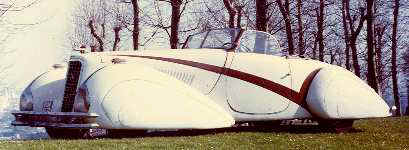
This is how the Hartmann car looked when Michel Payet got it from
Pat De Witte, shortly before the latter's death in the late seventies.
At the left is an interesting bird's-eye view with Michel at the wheel
[ Photos: © and courtesy M. Payet ]
The two long flag-staffs were fitted by Michel to help him
gauge the car's width while driving France's narrow roads
The Veedol Star Parade
The V-16 was loaned by Michel Payet to the organizers of the Auto-show der Superlative and Veedol Starparade that toured major cities in West Germany between May and October 1982. That event had been organized by Swiss businessman, Prosper du Bois-Reymond in partnership with Roman Weyl, a German car collector. On that occasion, the 1937 Cadillac had shared the limelight with the following other "super-cars" (inter alia):
1927 Rolls Royce Phantom (formerly owned by silent-screen star, Greta Garbo)
1935 Auburn Speedster
1936 V-12 Maybach Zeppelin
1941 Chrysler (Indianapolis Pace-Car)
1949 Talbot Lago roadster (with body by Saoutchik, Paris)
1955 T-Bird roadster (former owner: Marilyn Monroe)
1956 "Psychedelic" Bentley (former owners: The Beatles)
Mr. Payet reported that before the show went on the road, the organizers invested a few thousand French francs in minor mechanical repairs and some cosmetic work to the car. A full report on the German show appeared both in a color brochure published by Veedol and in Classic and Special Interest Cars, in the summer of 1982.
The Hartmann car on show in Berlin, in May 1982 (the
sign in the background reads "Pininfarina, Michaelangelo
of the Automobile"; equally apt, perhaps, would have been:
Willy Hartmann, Rubens of the Automobile
Unfortunately, the show appears to have been mismanaged and many of the private collectors who had loaned their beautiful cars found that they were required to bear a part or all of the cost of having them shipped back home. So it was for Mr. Payet and the Cadillac V-16!
Retro-Lyon,1983
From December 9-12, 1983, the V-16 was exhibited again at Retro-Lyon, a now popular annual event in Lyons, the provincial capital of France. A report on the 1983 meet was published in the French monthly magazine Nitro (equivalent to America's Hot Rod). As I mentioned before, it was Nitro that propagated the myth about the car having been designed by Figoni & Falaschi and built for South-American tin millionaire, Simon Patiño, a long-time resident of Geneva, Switzerland.
All the fun of the fair serves as a
fitting backdrop to a rare automobile
Retromobile, Paris, 1985
The Cadillac was seen next in public in Paris, from February 8-17, 1985 at the annual Retromobile show. At that show, whether by accident or design, it stood next to a 1938 Talbot-Lago roadster with a genuine body by Figoni & Falaschi. You will see in the photos, below, that the car still carried the two long flag staffs installed by Michel Payet. In France's Automobile Magazine for March 1985 there was a cutting in which the alleged "Patiño" connection was reiterated; the writer mentioned: ...unique cars that are rarely ever seen, like that impressive 1937 Cadillac convertible coupe with a 16-cylinder engine and body by Hartman [with only one 'n'] for a demanding client, Mr. Patiño, the "King of tin"...
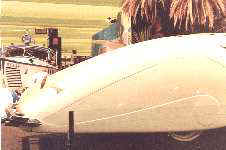
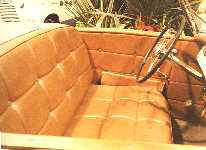
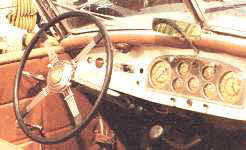
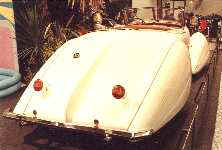

Left: in three of these photos are plainly visible the two long flag-staffs that were fitted by
Michel Payet. Right: the upholstery was restored by Jean-Jacques Belet, in 1970.
In a later restoration, the original biscuit and button design was changed to piping
Fifth Owner and 2nd Major Restoration [This paragraph was slightly amended in June, 2009, following a chat, in Las Vegas, with Don Williams, the most recent owner]
The car was on show in Paris, in 1985, during the Retromobile show. At that time it was in the hands of famed Parisian auto restorer, André Lecoq. I have not been able to determine if Lecoq had bought the car from Mr. Payet, or whether the latter had commissioned Lecoq to restore the car. According to Don Williams of the Imperial Palace collection, Las Vegas, and the Blackhawk Museum Collection in Danville, CA, he (Don Williams) made Lecoq an offer for the car; a gentleman's contract was entered into with a simple handshake. When Don came back, later, to discuss arrangements for shipping the V-16 back to the USA, Lecoq sheepishly acknowledged that he had accepted a higher offer from a wealthy Iranian-American businessman, a Mr. P.A. Parviz, a resident of London, England (Mr. Payet would not divulge the price paid by Mr. Parviz, the fifth owner; he said, nevertheless, that it was equivalent to the cost of "three or four" new Mercedes-Benz models [my estimate, at that time: $150,000]).
Mr. Lecoq informed me, by letter, that he had worked on the car for eight months. While he was adamant to quote any definitive figures, I assume that labor charges alone must have amounted to close to 400'000 French francs (approximately $65'000 at that time). Mechanical work, he said, had been limited to checking out the various components (engine, transmission, etc.), adjusting the brakes and rewiring the car completely. The Lecoq workshops put a lot of effort into upgrading the body and interior. Mr. Lecoq stated that the body was completely stripped down and new metal welded into the spots where rust had taken over. It was then re-sprayed with a nitro-cellulose lacquer.
At this time, a non-original metal panel, complete with central fin to match the existing fin on the rear body, was fashioned to cover the top boot when the car was used in the open convertible mode. Press studs were installed to hold the soft top in place in inclement weather. The original Chevrolet truck tail-lights were replaced with more streamlined, chromium-plated bullet tail-lights, similar to the kind used on the Cadillac V-16 models of 1932 and 1933. The circular, red reflectors were removed also during this second restoration.
The Lecoq workshops also replaced the original light tan upholstery with new, black leather. Seat and seat-back were fashioned in 3-inch, tufted piping that replaced the original Hartmann design featuring large biscuits and buttons. The original, large map pockets on the inner door panels were deleted and these panels were dressed with a sun-burst design, a popular trade-mark of Paris’ Jacques Saoutchik in the thirties.
Mr. Lecoq removed also the unsightly radio antenna from the RH side of the cowl, as well as the radio itself. The instrument panel was restored and finished in black lacquer in lieu of the original cream color. A large "St. Christopher" medallion [the patron saint of travelers] was placed in front of the driver in place of the radio. Simultaneously, some knobs and switches were replaced and the windshield wiper motor housings were chrome-plated. It is possible also that the "tear-drop" tail-lights currently (1999) seen on the car and that resemble those of the regular 1932 Cadillac models, were added by Lecoq.
The most unsightly part of the second major restoration was, in my opinion, the non-original chrome-plating of the raised panels on the front and rear fender covers. Although European coach-builders such as Figoni & Falaschi and Saoutchik often used such extensive expanses of chrome-plating on their more lavish, Salon creations in the thirties, its gleaming presence on this huge American automobile looked completely out of place.
It is most unfortunate that neither Belet nor Lecoq had access to the original, early photos of the car nor any contact with either Willy Hartmann, the designer, or Philippe Barraud, the first owner. As a result, the front ensemble, lateral design and interior of the restored car now differ quite radically from the original car.
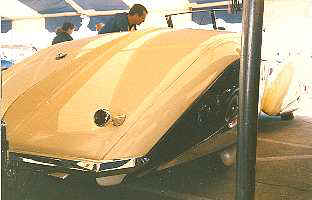
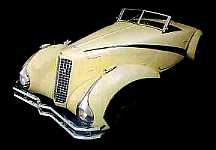
Quality restoration was done by André Lecoq of Paris, France;
Mr. Lecoq modified considerably the interior, including
the design of the seat, seat-back and inner door panels
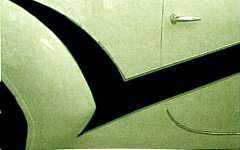
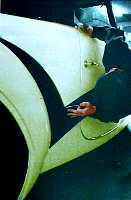
Intricate detailing included painstakingly pinstriping by hand the various body moldings and hood vent openings
There has been already so much myth, inaccuracy and hype surrounding this car that I would not be surprised if I saw it advertised for sale again, in a few years time, for $5,000,000! It might well be described then as a V-16 Cadillac "...designed by Figoni et Falaschi, with an interior by Jacques Saoutchik and custom-tuned engine by Hartmann, Switzerland ...a car with the elegance of French master coachbuilders and the precision of a Swiss watch !"
The V-16 Roadster Goes "Back Home"
In September, 1985, the V-16 roadster returned to its native America, following almost a half century spent in the olde worlde (35 years in Switzerland and 15 years in France).
In January, 1986 it was offered for sale at the annual Barrett-Jackson auction in Scottsdale, Arizona. It was named the V-16 roadster by "Von Hartmann". I assume that name was copied from the Veedol Star Parade program, written in German. In that language, "von" simply means "by". In other words, this was not the "Von Hartmann" roadster but simply the "roadster by Hartmann". Yes, Barrett apparently does have a problem with foreign names and phrases!
Auction results published in February 1986 show that the car was bid up to $475'000, which, in my opinion, was about $200’000 more than its intrinsic worth at that time. It did not find a buyer. Presumably the owner's reserve was much higher.
Later that same year the V-16 was shown at the annual Pebble Beach Concours d'Elégance where it was greatly admired. There was a brief report on that event in Old Cars Weekly for September 18, 1986. At that time, the owner of the car was still identified as Mr. P.A. Parviz of London. Perhaps he had a lay-away arrangement with Mr. Barrett.
The Sixth Owner-Speculator ...and a lot of hype
Although I have found no record of the transaction, I assume that Mr. Parviz eventually sold the car in late 1986 or early 1987 to well-known collector-auctioneer, Thomas Barrett III. I caught a glimpse of the car, in mid-1987, in a magazine called The Duesenberg Experience; on page 20 was a picture of the new owner standing amidst what was described in the caption as a part of his vast car collection. Clearly visible in the background, on the right of the photo, was the huge Cadillac V-16 roadster in its latest incongruous and gaudy garb.
Tom Barrett II with two cars in his collection;
Left, a 1934 La Salle; right, the Hartmann V-16
Considering the number and wording of the various ads run in the specialized press immediately after the last-but-one owner acquired the car, in my opinion he bought it merely for speculation, probably hoping to cash in on the much-bandied Figoni-Falaschi myth.
The Myth is perpetuated
The car was regularly advertised for sale in the mid- to late eighties, by Thomas W. Barrett III, in various hobby publications, but principally in Hemmings Motor News; it was described variously (and sometimes untruthfully) as:- 1937 Cadillac V-16 Fagoni-Flaschi [sic] designed 2 passenger roadster [wrong spelling of Figoni & Falaschi as well as untruthful assertion that they designed this car].
In this view it is not easy to see that the raised "teardrop" shapes
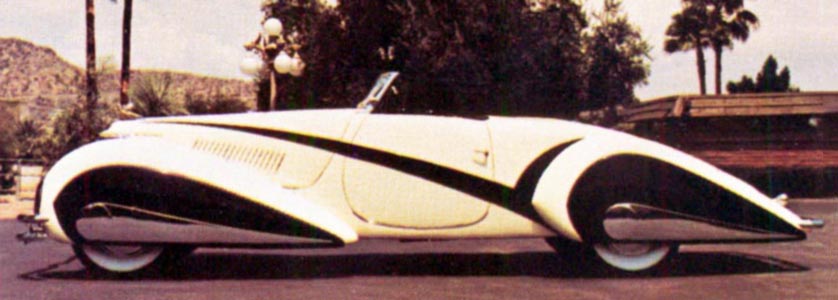
on the front and rear fenders have been chrome plated (!)- 1935 Cadillac V-16 Roadster [wrong year], body by Hartmann [correct!], design by Fagoni/Falaschi [again a mere assumption and the name Figoni is spelled incorrectly].
- 1937 Cadillac V-16 two-place roadster with a one-of-a-kind body by Figoni & Falaschi [untruthful assertion but correct spelling of the coach builders' names]. Built for Betino Tin Magnet [what the copy writer presumably meant was built for Simon Patiño, the tin magnate]; this, again, is a false assertion since we know the car was effectively built for Philippe Barraud, a Swiss roofing tile manufacturer. Stored in Switzerland for most of its life [the word "stored" is incongruous considering that the car lay in an open field, close to my home, for three years]. 155-inch wheelbase [in fact, 154 inches]. Largest Cadillac V-16 ever built, 21 feet long. Price $1,250,000 [this ad appeared in Hemmings in April, 1987].
- 1937 Cadillac V-16 Roadster, Figoni & Falaschi body [once again a false claim but correct spelling of the coach builders' names], 22-feet long, one of a kind, price $1,000,000 [note how the price was knocked down by a quarter-million dollars in a six-month period; this ad appeared on 2 pages in Hemmings for October, 1987].
- 1937 Cadillac V-16, Figoni and Falaschi body [a false assertion again]. Newly restored. Price $2,500,000 [this ad appeared in Hemmings in April, 1989]; the car appeared a dark color in this B&W ad, so I'm assuming this was after it had been repainted "prize-winning red". Are we to believe that the "new restoration" work cost all of $1.5 million dollars?
- 1937 Cadillac V-16 two-door convertible, body by Hartmann [at last, the whole truth and nothing but the truth!] Price $3,500,000 [this classified ad was part of a three-page Barrett-Jackson spread; unfortunately, two of the photo captions were inverted and so a Mercedes 600 Pullman limousine from the sixties was pictured where the V-16 photo should have been; I guess the vendor thought that nobody in the USA had ever heard of Willy Hartmann and so the ad asserted that this V-16 was built on a "...design by Fagoni/ Falaschi" [more assumptions and incorrect spelling of Figoni]. That "designer label", it seems, was enough to hike the price up by a further million dollars over the previous ad!
- 1935 Cadillac V-16 Roadster [wrong year again], body by Hartmann [correct], design by Fagoni/Falaschi [assumptions and mis-spelling of Figoni continue]; the latter classified ad appeared in Thoroughbred & Classic Cars in January, 1990.
In spite of these attractive ads, the car did not sell. Potential buyers presumably were baffled by the corrupted rendering of the myth about the car having been built for Simon Patiño, the "King of Tin," a tall story that had been spread, initially, by France's Nitro magazine and uttered again in France's l'Automobile Magazine for March 1985.
The repeated, untruthful assertions about the car having a "...one-of-a-kind body by Figoni & Falaschi" probably was a deliberate attempt by the vendor to artificially boost the roadster's potential value as a rare collectible automobile. Indeed, nobody in America, in the eighties, had ever heard of Willy Hartmann; on the other hand, collector cars with authentic F&F bodies were selling in the eighties for high six and low seven figures.
On October 22, 1987, I wrote to the Barrett-Jackson organization and made a point of trying to have corrected the myths [lies?] that were being propagated about the car. I provided ample documentary and photographic evidence (1) that the Hartmann V-16 did NOT have a body by Figoni & Falaschi and (2) that it had NOT been built for Simon Patiño. My letter was never acknowledged. The folks at Barrett-Jackson were not about to publish the TRUE facts about the car ...and thus diminish its "worth" in the eyes of potential buyers.
In a magazine article [Auto Gallery, September 1987], Dennis Adler, the well-known auto-columnist, continued to propagate and expand on the myth that the Hartmann car had been built for a rich South-American millionaire. In October of 1936, he said, South American industrialist Carlos [actually Simon] Patiño was visiting the Paris Auto Salon, saw the Figoni et Falaschi Delahaye, and decided to have one like it ... so Patiño took his V-16 to Switzerland, and there commissioned the coachbuilding firm of Hartmann to copy [!!!] the 1936 Figoni Delahaye." A good story, Dennis, but a wee bit off the mark!
Interestingly, Mr. Adler mentioned in his article that the Hartmann car had been auctioned in Phoenix [Scottsdale?], AZ, on January 23, 1988, to Ken E. Behring of the Blackhawk Museum in Danville, CA, for a reported $750,000 ...a far throw from the $3,500,000 ticket that Tom Barrett put on the car the next year ...and later! A Swiss friend and collector who attended the annual Scottsdale venue in 1988 said that the V-16 roadster had found no buyer; he does not recall the amount of the high bid, if any. No other ads that I know of appeared for the Hartmann car in 1988.
A little more than a year later, In April 1989, new ads began to appear for the car. Again it was stated untruthfully (despite my letter to Tom Barrett) that it had a "...Figoni & Falaschi body". The car was described as having been newly restored. I don't know if the V-16 was on the block in Scottsdale in January, 1989; I suspect it may have been undergoing further "restoration" at that time, including being repainted "collector car red" to further enhance its marketability.
In Auto-Week for January, 1990, it was said that the Hartmann V-16 had been sold [for the 2nd time?] to Ken Behring of the Blackhawk Auto Museum in California, this time for $1,400,000, during the weekend auction of 18-21 January, 1990. If this were true then, as I surmised, there was "no sale" at Scottsdale in 1988, but possibly a high bid. Indeed, it was reported that same week in Old Cars Weekly [January 4, 1990] that the car was part of Tom Barrett’s private collection. So, there is definitely more to this story than meets the eye! Another press cutting, reporting on the auction, said: ...a 1937 V16 Harman-bodied [sic] Cadillac roadster went for $1.4 million. In the body of the article it was stated, ...next in line was a 1937 Cadillac V16, Hartmann-bodied roadster, which went for $1.4 million.
[ Source: Auto Week, Jan. 1990 ]
In the British monthly Thoroughbred and Classic Cars, January 1990, there was a two-page spread about the 1990 edition of the annual classic car auction at Scottsdale, Arizona. The text accompanying a photo of the Hartmann car read correctly [apart from the year of the car] "...1935 Cadillac V-16 Roadster, body by Hartmann".
Although I had sent the owner documentary proof of the car’s Swiss ancestry, the false Figoni et Falaschi appellation continued to appear in all the sales advertisements listed above. In fact, when I admired the car again at Retromobile, in Paris, in 1991, I was horrified to see that the original Hartmann ID plate that I had photographed on the dash, in the seventies, had been removed [by whom?] and replaced with a new, modified one that included the words (in French) Dessin Original Figoni & Falaschi [i.e. Original Design by Figoni & Falaschi]!
Some people will stop at nothing to sell a classic car?
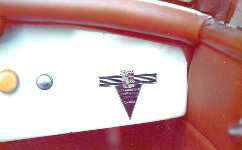
In the mid-eighties the original coach-builder's nameplate was removed from the RH corner
of the instrument panel [ RH photo, above, © 1974, Yann Saunders ] and replaced with a fake
one on which were added the words (in French) "Original Design - Figoni Falaschi" [LH photo]
Why would the vendor of a car with a known history deliberately and fraudulently misrepresent it to potential buyers? In my opinion, this excerpt from Milestone Car, the magazine of the Milestone Car Society of America, that appeared in 1973, provides a plausible explanation:
The supply of Figoni et Falaschi designs available to the collector is strictly limited today, and those that have survived
and occasionally come up for sale bring prices that rank with the cream of the classics ...One can easily understand why the vendors preferred to see the car associated with the renowned French coach-builders rather than with an unknown Swiss artisan!
Third Restoration & Facelift
Presumably owing to the early unsuccessful attempts to sell the car (in the period from 1987 to 1989), it was decided to "re-vamp" the Cadillac in the hope of further enhancing its marketability. During the third restoration in 1989 which - in my opinion - was totally unnecessary, the original gas-filler cap was recessed below the rear deck, access being now through a flush-mounted, hinged panel. The convertible top studs were removed to accentuate the smooth curves of the rear body. The car was repainted for the fourth time in its history; the color chosen was fire-engine red (vermilion). No doubt the owner wanted to verify the old adage about red cars always winning the first prize ...or, in this case, fetching the highest selling price! That repaint destroyed the delicate pinstriping that had been meticulously and painstakingly applied by André Lecoq's team.
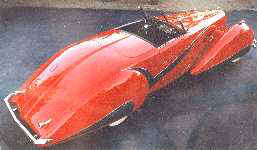
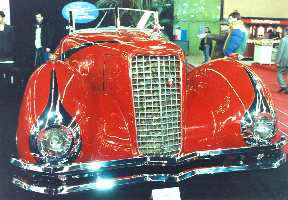

Left & Right: the car after some more
modifications and a repaint to red; center: on display at Paris' annual Retromobile
show

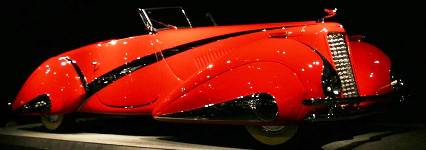

The Hartmann V-16 after the 1989
"face-lift", on display in Ken Behring's Blackhawk Museum collection, Danville,
CA

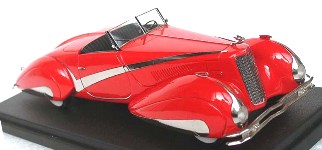

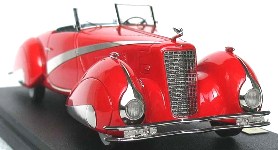
Looks like the real thing, huh? Here we see the final
(?) version of the modified Hartmann design, by the last-but-one owner,
the late Tom Barrett III; once again, we have EMC in the Ukraine to thank for this
wonderful 1:43 scale replica
On a humorous note, I read in Autoweek for February 19, 1990 that The old rascal himself, auction founder Tom Barrett, parted with his outrageous '37 red "Cadillac" roadster, which bears no resemblance to any Cadillac or, for that matter, to anything ever made. The work of Hartman [again with only one 'n'] of Zurich [actually, Lausanne] in those zany days before World War II, this car makes the Auburn Boat-tail look toadish (one sold for $210,000). A while back, one of Barrett's numerous ladyfriends, in a gay moment, drove another of his cars into the garaged '37, adding $145,000 to the evening's expenses. Ah, well, Tom got $1.4 million from the Blackhawk boys [Ken Behring and Don Williams]. "I love that car, but I was glad to see it go because I had such sad times with it," he said.
The last but one time I got close to the car was a year later, in Switzerland, during the Geneva Auto Show (March, 1991). The newly-painted-red car was exhibited, along with others, under the banner Barclay Fascination Cars [Barclay is a brand of cigarettes actively promoted and sold in Switzerland].
Nina Padgett, writing in Autoweek for March 17, 1997 (and obviously quoting almost verbatim the story of the Hartmann Cadillac published jointly by Ron Van Gelderen and myself in the glossy, annual Self Starter magazine for 1990) repeated the same mistake that I had made when I inverted the words "front" and "rear" when referring to the position of the door hinges. In fact, the doors of the Hartmann car are hinged at the front, whereas those on the regular Cadillac "Sixteens" for 1937 are hinged at the rear. Nina's story does differ slightly from my own in that she asserts that Mr. Parviz, the fifth owner, shipped the car to the USA before Lecoq was able to complete the second restoration. He (Parviz) was hoping to sell it quickly, but two years apparently passed before it was acquired by Tom Barrett. Nina said Barrett completed the restoration begun by Lecoq and had the car painted red. She asserted also (remember, she was writing in 1997) that the car is displayed "on loan" at the Blackhawk Museum, suggesting the car was still owned at the time by Tom Barrett.
Three different restorations: [left] Switzerland, 1970), [center] France, circa 1985, [right] USA, 1989.
In my opinion, the final restoration [right] is an insult to both Willy Hartmann, the creator, and André Lecoq,
France's finest classic car restorer. The car is now "fire-engine red" and glitters with vast expanses of chrome!
Major changes from the original design
BEFORE
AFTER

Fine-ribbed vertical grille, matching tear-drop running lights, "
paired "bumperettes", V-16 emblem top RH of grille,
"Acorn" turn-signal lamps at bumper extremities
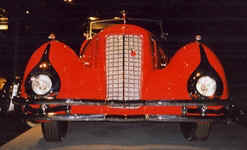
Egg-crate grille, missing tear-drop running lights,
full-width "Batain"-type, hexagonal bumpers,
V16 emblem on LH side of grille; turn signal lamps deleted
Cloth tonneau cover,
visible fuel filler cap
metal tonneau cover with "fin"

Acorn turn-signal indicator lamps mounted under 1936 Chevy tail-lights;
country plate and license tag holders mounted above tail-lights,
flat-blade, double (?) bar rear bumper
1932 Cadillac styled tail lights;
no rear license-plate mount,
"Batain" type hexagonal rear bumper

Body-colored dash;
biscuit & button seat, seat back and door panel design
Black dash, instruments moved; 3" piping on seats,
"sunburst" design on door panels
What is the Hartmann Car REALLY worth
Even if this V-16 car had been restored to its former, original splendor, respecting the coach builder's original design for the front ensemble, as well as the original color scheme, upholstery pattern and instrument panel layout, still its current value would be nowhere near the prices that have been asked for it. And even if the car did have a genuine body by France's Figoni & Falaschi team, its current value - in my opinion - would be no more than $500’000, which is still five hundred times more than the second owner paid for it in 1969!
Sure, the car is a Cadillac. Sure, it is a V-16. Sure, only fifty V-16s were built in 1937. Sure, it is a roadster - the most desirable of all body styles - and, sure, it is fitted with a unique body. But it is not and never was a car built (or designed) by Figoni & Falaschi.
Whoever heard of Willy Hartmann of Lausanne, Switzerland, before this V-16 literally was dragged out of the bushes in the late sixties?
Let not a three-and-a-half million dollar ticket pull the proverbial wool over the eyes of the unsuspecting emptor ! This is no Bugatti Royale nor any pristine Duesenberg "J". The body, while unique, is not built to the standard of the crème de la crème of contemporary European coach-builders like Hooper or Mulliner in England, Fernandez & Darrin, Figoni et Falaschi, Kellner, Letourneur et Marchand or Saoutchik in France, Erdmann & Rossi or Gläser in Germany, Nordberg in Sweden, Van den Plas in Belgium nor even Hermann Graber in Switzerland. Willy Hartmann did not possess the skills and techniques of the latter, world-class and world-renowned coach builders.
Despite the reputation of the Swiss for fine-quality workmanship, the second and third owners of the Hartmann car confided in me that Willy's talents as a coach-builder were no match for those of the great European and American coach-builders of the time. On Hartmann's own admission when I interviewed him in 1987 [he was then aged 86], the only reason he ever got to tackle a Cadillac, let alone a V-16, was on account of the proximity of his small workshop to the home of wealthy Philippe Barraud.
For a car of these gigantic proportions and on a scale of one to ten, this car [below, right] gets only a two in my book, in terms of quality of construction and finish. In comparison, the corresponding Fleetwood convertible coupe built the same year - style #5835 [below left] - deserves an eight!
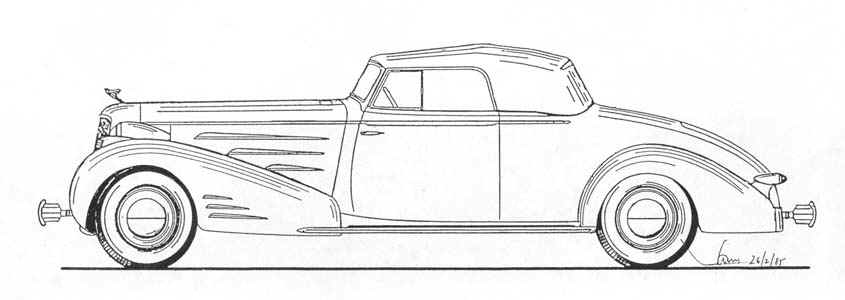
Left, Fleetwood style #5885 [or 5785] convertible coupe proposal for 1937 [only two were built]
Right, the "awesome" Hartmann roadster [only one was built ...and that was enough!]
Both hand drawings, above, are by Yann Saunders (the one at the left is from an original 1937 Fleetwood proposal)
Nevertheless, viewed simply as an objet d'art, the Hartmann V-16 has exceptional appeal. Place it side by side with a comparable roadster built by Figoni & Falaschi on the Delage, Delahaye or Talbot chassis and you'll see what I mean!
So, what is the Hartmann V-16 really worth? Well, if you simply add up the cost of the Lecoq restoration, the cost of having it transported back to the USA and the most recent "face lift" in 1989, it's just possible that the total could reach $350'000. So the "profit margin" on this car was over $1,000,000! Merci, Messrs. Figoni et Falaschi !
As they say, caveat emptor !
Conclusion
Even though - in my opinion - the car is not worth one quarter the ticket prices seen since 1987, still it deserves a place in the Automobile Hall of Fame. I love it and hate it too! This fire-engine-red mammoth is also something also of a white elephant. I think it is probably the most enormous, outrageous and utterly preposterous two-passenger car ever built and ever to carry the distinguished coat of arms of Sieur Antoine de la Mothe CADILLAC!
The Hartmann V-16 roadster is currently [1999-2009]
in the renowned Blackhawk Auto Museum, Danville, CA.
Late Extra [June, 1999]: On a trip to California, where Gita and I attended the annual Cadillac-LaSalle Club, Inc. "Grand National" meet, the organizers had included a visit to the renowned Blackhawk Auto Museum in Danville, located some 45 miles NE of San Jose. Thanks to an introduction by a member of the CLC of Northern California and owing to the generous courtesy of the museum staff, I was allowed to clamber up onto the dais on which the Hartmann car is displayed, and to photograph up close the fake coach builder's plate now mounted on the RH side of the instrument panel. My worst fears were confirmed. Someone intent on increasing the car's status had taken the extreme liberty of removing the original plate and affixing a new one with the following additional inscription: "DESSIN ORIGINAL FIGONI FALASCHI" [i.e. "Original Design Figoni Falaschi"]. Below is the proof of my assertion: on the left is the original Hartmann plate that I photographed in Mâcon, France, in 1974; on the right the new, fake one.
Sorry for the poor photo quality; both are from TV/video footage I shot and both have been retouched for improved
contrast. I photographed the original builder's plate [left] on the car in Mâcon, France, in the early seventies;
the background appears to be blue but in fact it is black; at that time the instrument panel was cream in color,
just like the car itself. On the fake plate [right], note the black merlettes as well as the wider spacing
between the Cadillac crest and the lower inscription; note also the different print used; in addition, only the
word Cadillac is italicized on the fake plate, whereas on the original the word LAUSANNE also was in italics
This is a regular emblem off a 1934 V-16 instrument board
Later [June, 2009]: On a trip to Las Vegas, where Gita and I were attending yet another annual Cadillac-LaSalle Club, Inc. "Grand National" meet, a visit to the renowned Imperial Palace auto collection was included among the planned activities. While touring the show, I noticed on the wall of the exhibit's "office" area a photo of the Hartmann V-16 in its latest, red garb. I got chatting with Rob Williams (son of Don) who was surprised that I had named the car correctly as the "Hartmann V-16 roadster". We were joined by his father, Don, who corrected and complemented some of my earlier "facts"; he mentioned, for example, that André Lecoq had reneged on a gentleman's agreement to sell him (Don) the car; Lecoq had broken his word and accepted a higher offer from another buyer, a Mr. Parviz of London. Parviz subsequently sold the car to Tom Barrett, the collector and auctioneer from Phoenix, AZ. Don ultimately bought the car from Tom Barrett, some five years later. He asserted also that the fake "F&F" nameplate had been put on the car by Tom Barrett.
Later still [March-April, 2010]: commenting on some photos that were featured on Yahoo's "Flickr" image galleries, photographer and auto buff Wayne Craig of Lodi, CA, one of a number of docents at the Blackhawk Museum, commented that a great deal of controversy arose when Figone [sic] and Falaschi sued Mr. Hartman[n] over his design that heavily resembled a F&F design. The coachbuilder’s plate that currently rested [rests?] on the dash board is the result of that settlement and now indicates both coachbuilders [who] influenced the design. In my opinion, Mr. Craig is referring to the legal wrangling that opposed F&F to French automobile artist, George Hamel (aka Geo Ham) in the mid-thirties and that concerned an alleged F&F design for a 1935 Delahaye Type 135M roadster with fully enclosed front and rear fenders shown at the Paris Salon the following year. Eleven of these roadsters were built and as a result of a court order all of them carried two "designer labels", those of F&F and that of Geo Ham. As to the "questionable" coach builder's plate on the dash of the Hartmann car, I assumed it had been added some time after the car was acquired in Paris by the late Tom Barrett, i.e. in the mid-eighties, in an effort to boost its "collectibility"; as mentioned above, my assumption was proved by Don Williams to be correct. In any case, by the time Barrett bought the car, Figoni (who was born in Dec. 1892) and Falaschi would have been in their late 80s or early 90s. Had they wanted to sue, at all, the defendant would have been Willy Hartmann, in 1937, not Tom Barrett, 50 years later. Figoni ceased designing and building "custom" cars in the 50s, while his partner, Falaschi, who had financed the couple's operations, was back in Italy running a hotel.
Latest [April, 2010]: I have it from a reliable source that the Hartmann V-16, although still on show at the Blackhawk Museum in California, is owned (and has been already for some time) by Korean billionaire, Lee Kun-Hee, former chairman of the the Samsung Group. He resigned his position after being charged with tax evasion and breach of trust, although the latter charges were subsequently dropped. Married and father of three, his fortune is estimated at $3.9 billion (a 4th child, a daughter, Lee Yoon-Hyung, was reported by The Independent in November 2005 to have committed suicide in her Manhattan apartment, in New York).
The Hartmann car in miniature
Want to see a FABULOUS replica in 1:43 scale
created in the Ukraine from photos of mine?
Want to see a 1:8 Scale exotic wood sculpture
of the Hartmann Car?
Click here
Bibliography
I should like to extend particular thanks to the following individuals without whose enlightened help all the pieces I was able to assemble of the Hartmann "puzzle" could not have fallen into place:
Mr. Willy Hartmann, proud "progenitor" of this extraordinary automobile. He admitted, when I interviewed him, in 1987, that even in his wildest dreams, he never could have imagined all the adventures that were to befall the car that had once been merely a drawing on a sketch pad for a prospective client.
Mr. Philippe Barraud, the first owner of the car. Despite his age and failing health [he was 75 years old when I interviewed him in 1987], this fine old gentleman was kind enough to answer my many questions about the wonderful automobile that had been his favorite "toy," fifty years beforehand.
Mr. Jean-Jacques Belet, second owner of the car who was able to dig up some early photos for me and to fill in missing details for the period from 1968 through 1972.
The late Mr. Patrice de Witte and his charming wife who welcomed me often in their château-home near Mâcon, allowed me to play with their incredible toy and generally entertained the many Cadillac buffs I brought from near and far to see this incredible V-16.
Mr. Michel Payet, who acquired the V-16 from Mr. de Witte shortly before the latter passed away, and who told me the story from where he had picked up the threads.
Mr. André Lecoq, France's premier automobile restorer who did the best job he could to restore the V-16 in 1985, in the absence of any original designs or early photos of the car.
Mr. Alain Berrabah, a Swiss Auburn-Cord-Duesenberg fan-and-friend-nevertheless who, despite his young age probably knew more about the history of the Hartmann V-16 than the rest of us put together; Alain it was who supplied many of the early (1937) photos for this story.
Mr. Christian Vaney, a long-time friend and Cadillac buff who had seen the huge car before me and whetted my appetite for more facts and photos.
Mr. Eddy Strebel of Switzerland's Automobil Revue who tipped me off to the car's location in France.
Mr. Don Williams of the "Imperial Palace Collection", Las Vegas, NV, who filled in a few blanks between the the time the car was in André Lecoq's restoration shop in Paris and when it joined Thomas Barrett's collection in Phoenix, AZ.
| CABRIOLET CADILLAC V-16 ANNEE 1937 No de chassis : 5B 328 [erreur de copie:
"B" = "13", donc 5(13)0328] LISTE DES PROPRIETAIRES: 1. M. Philippe Barraud, Lausanne
(1937-1969) HISTOIRE (résumé): M. Barraud est le fils d'un riche entrepreneur de la Riviera vaudoise, en Suisse, qui a bâti sa fortune dans les briques et les tuiles (les Tuileries Barraud ont changé de nom mais existent toujours). Il veut s'offrir une auto ayant la même "gueule" que les Talbot et autres Delahaye de ses copains...mais avec un petit "plus". Ce petit "plus" il le découvre en feuilletant le catalogue FLEETWOOD de 1937 où il tombe en admiration devant les deux modéles V-16 qui y sont illustrés. Sans plus tarder il commande chez l'agent CADILLAC de Lausanne, un chassis V-16 nu dont il confie l'habillage à un jeune carrossier lausannois, voisin, peu connu à l'époque, Willy HARTMANN. Barraud aurait trés bien pu faire carrosser sa voiture à Paris par Franay, Million-Guiet, Vizcaya ou même Figoni et Falaschi; mais il est jeune et ne supporte pas l'idée de ne pouvoir surveiller tous les jours l'avancement des travaux. Le chassis arrive en gare de Lausanne par le rail, en provenance du dépôt GM à Anvers, en avril 1937. La carrosserie est achevée au mois d'août de la même année. Elle est de couleur crème avec une large bande décorative de couleur orange, cette couleur étant reprise sur les motifs arrondis des cache-roues AV et AR. D'après les souvenirs du carrossier et du propriétaire, que j'ai eu la chance de pouvoir recueillir en 1987, le chassis avait coûté la bagatelle de 30'000 francs suisses de l'époque et la carrosserie 12'000 francs de mieux! Elle est immatriculée pour la première fois à Lausanne le 25 août 1937 sous le numéro VD2264. Philippe s'en sert jusqu'à fin 1939 quand le carburant vient à manquer (même pour les gens fortunés). Pendant 10 ans, elle repose dans un hangar au bord du lac Léman. Au printemps '49 Philippe dépoussiére sa Cadillac et décide le moment venu de lui refaire une beauté. Il lui conserve la teinte de base mais décide de changer la couleur des bandes décoratives, passant de l'orange au bleu-ciel. Puis il la présente pour la deuxième fois à l'inspection technique de son canton. Elle est réimmatriculée sous le numéro VD19044. Il s'en sert ainsi de façon assez sporadique pendant encore 5 ou 6 ans. A la suite d'une collision frontale, l'avant de l'auto est fortement endommagé, il la fait réparer et en profite pour changer à nouveau la teinte, optant cette fois pour un fond café-au-lait très clair et des bandes décoratives de couleur chocolat foncé. Les feux de position en "goutte d'eau," démolis, sont remplacés par des modèles courants achetés dans le commerce. En raison de l'Expo suisse de 1964, Philippe se voit contraint de libérer le hangar qu'occupe sa "vieille" Cadillac à Ouchy, dans la banlieue lacustre de Lausanne. Aussi la confie-t-il à un ami qui posséde un terrain dans l'arrière pays vaudois. Elle y attire une foule de curieux qui l'approchent souvent de trop près; M. Barraud décide alors de la déplacer. La nouvelle "cachette" est néanmoins découverte, en été 1968, par un membre du Vétéran Car Club Romand [le "VCC"de la Suisse romande], M. Jean-Jacques Belet qui "harcèle" M. Blaser, la personne qui en a la garde, jusqu'à ce que celui-ci consente à la lui vendre. En acceptant de vendre le 4 février 1969, pour la somme de FS4500 ce qu'il considère une "épave" (elle est en bien triste état; de petits arbustes commencent même à pousser dans l'habitacle et elle occupe beaucoup trop de place), M. Blaser estime rendre un sacré service à M. Barraud qui la lui a confiée en dépôt. Malheureusement celui-ci ne l'entend pas de cette oreille et tente même de récupérer la Cadillac par la voie juridique, mais sans succès. M. Belet entreprend la restauration de la Cadillac mais ayant rompu le contact avec le précédent propriétaire, il ne dispose d'aucune photo lui permettant de respecter le dessin d'origine. Il manque par exemple une partie de la calandre, les feux de position en "goutte d'eau", les demi-parechocs bi-lames d'origine et les plaquettes d'identité du carrossier. Cependant, il a la main heureuse en optant pour la couleur crème avec des bandes décoratives brun foncé. C'est sous cet aspect que dès le printemps 1970 on recommence de parler de la CADILLAC V-16 Hartmann dans le cercle réduit des collectionneurs suisses de vieilles autos. En 1972 à l'occasion d'une sortie du VCCR, M. Belet fait la connaissance d'un collectionneur français, Patrice (dit "Pat") de Witte; l'un et l'autre se prennent "d'amour" pour l'auto de l'autre et décident de "faire l'échange". C'est ainsi que la Cadillac prend le chemin de Mâcon où je la retrouve l'été suivant. Dans un article paru dans plusieurs revues spécialisées je la fais connaître en Amérique où elle fait l'effet d'une bombe. Je reçois par la suite la visite de nombreux collectionneurs qui souhaitaient tous que je les présente à M. de Witte afin qu'ils puissent admirer la Cadillac de près, ce que je fais d'autant plus volontiers que c'est toujours un plaisir pour moi que de rendre visite au charmant couple De Witte ...et caresser les flancs de cette voiture exceptionnelle. En y réfléchissant bien, si j'en avais eu les moyens à l'époque, je pense que Pat De Witte aurait peut-être accepté de me céder sa CADILLAC pour environ 50'000 francs suisses. Malheureusement je n'avais pas le premier centime qui m'eut permi de lui faire une telle offre. En février 1977, M. De Witte qui malheureusement devait décéder peu de temps après, vend la CADILLAC à un autre collectionneur français, Michel Payet, de Caluire près de Lyon. M.Payet m'avoue avoir versé, pour acquérir la Cadillac, l'équivalent du prix d'une belle Mercedes d'occasion. C'est lui qui fait ajouter aux extrémités du parechocs AV les longs porte-fannions que l'on peut voir sur certains clichés de l'époque. De mai à octobre 1982 la CADILLAC fait partie d'une exposition itinérante à travers l'Allemagne de l'Ouest (la "Autoshow der Superlative und Veedol Starparade" organisée par un homme d'affaires suisse, Prosper du Bois-Reymond et un collectionneur allemand réputé, Roman Weyl. Avant de l'exposer, les organisateurs dépensent quelques milliers de francs pour remettre la Cadillac dans un état plus présentable. Malheureusement, ils voient un pu trop grand et l'exposition itinérante tourne au fiasco de telle sorte que M. Payet se voit contraint de rapatrier la Cadillac en France à ses frais. Entre le 9 et le 12 décembre 1983 la V-16 fait une brève apparition à "Rétro-Lyon" à la suite de quoi on lui consacre un article dans "Nitro". C'est cette revue qui propage alors de fausses informations relatives aux origines de la Cadillac, prétendant qu'elle a été carrossée à Paris par Figoni et Falaschi pour Simon Patiño, roi de l'étain. Du 8 au 17 février 1985, la Cadillac est exposée à Rétromobile où elle partage les feux de la rampe avec une superbe Talbot bleue carrossée, elle, par les maîtres incontestés de l'époque, Figoni et Falaschi. C'est à la suite de cette exposition et grâce aux fausses rumeurs propagées ci et là concernant son origine que la Cadillac change à nouveau de propriétaire en passant cette fois aux mains d'un riche spéculateur irano-américain, M. Parviz, pour une somme équivalent au prix de 3-4 Mercedes neuves. Celui-ci la confie aux ateliers André Lecoq à Paris où elle subit une seconde restauration. M. Lecoq, pas plus que M. Belet, ne dispose de documents ou de photos d'époque et laisse donc son imagination le guider. En Septembre 1985, près d'un demi-siècle après avoir quitté son pays natal à bord d'un cargo à destination du vieux monde, la CADILLAC V-16, habillée de sa robe "haute-couture" et prétenduement parisienne, fat une rentrée très remarquée au pays. En janvier 1986 elle est présentée à la vente annuelle Barrett-Jackson, à Scottsdale en Arizona. Les enchères grimpent jusqu'à $475'000 (soit 475 fois plus que le prix payé par M. Belet en 1969!) mais la voiture ne change pas de mains, les enchères étant jugées trop ...modestes!!! Je la retrouve dans le revue "Hemmings Motor News" en avril 1987 où elle est proposée pour la bagatelle de $1'250'000 !!! Aucun acheteur ne se fait encore connaître mais cela suffit à en faire un mythe, son prix "estimé" étant équivalent à celui d'une Bugatti "Royale". Imaginez la joie d'un collectionneur peu averti qui, ayant vu le prix demandé, avait la possibilité de l'acquérir "au rabais" en ne la payant "que" $800'000!!! Elle fait une nouvelle apparition dans "Hemmings" au mois d'octobre 1987. Le vendeur a baissé son prix de $250'000; elle est offerte désormais au prix de "seulement" $1'000'000. On peut lire, en grosses lettres, sous une belle photo de la voiture, les mots "Carrosserie Figoni et Falaschi". Je m'élève naturellement contre ces indications fausses voire délibérément mensongères (...en ayant toutes les preuves à l'appui). Il va de soi que l'annonceur n'a pas même la politesse d'accuser réception de ma lettre. En janvier 1988 on la propose aux enchères chez Barrett-Jackson pour la deuxième fois. Aucun acheteur ne s'y laisse prendre. De nouvelles "petites" annonces de grand format font leur apparition dans la presse spécialisée, en 1989; la Cadillac y est proposée alors au prix "fou" de $3'500'000! Elle a subi entre temps quelques nouvelles retouches à la suite d'un petit accident survenu dans la propriété de M. Thomas Barrett (3ème du nom) à Los Angeles; une amie de la famille l'avait abîmée alors qu'elle se trouvait dans la garage de la propriété! C'est l'occasion de la repeindre, en rouge "pompier" cette fois. On fait aussi disparaître le bouchon du réservoir d'essence sous un petit volet articulé pour rendre la voiture encore plus aérodynamique. Nouvelle tentative de vente à Scottsdale, en Arizona, au mois de janvier 1990. Cette fois-ci, la Cadillac grimpe jusqu'à $1'400'000 et change enfin de mains. Il ne fait aucun doute, à mon avis, que Barrett a réalisé un bénéfice énorme sur la vente de cette voiture (entre $800'000 et $900'000 au bas mot!). Elle est entrée au "Blackhawk Automobile Museum" à Costa Mesa, en California ...en méme temps qu'elle est entrée dans la légende! Pour ma part, je reste convaincu que même restaurée à la perfection (ce qui est loin d'être le cas selon les indications fournies par M. Belet, le deuxième propriétaire) cette CADILLAC, malgré la rareté des seuls cinquante chassis V-16 construits en 1937, ne "vaut" pas plus que $400'000, d'autant qu'elle ne ressemble désormais plus du tout à celle que Willy Hartmann avait livrée à Philippe Barraud à l'automne 1937. Et que dire de ces cache-roues et de cette large bande latérale chromés? S'agit-il d'une merveille de la carrosserie européenne de la fin des années trente ou au contraire d'un vulgaire hot-rod couleur "pompier"? Il ne suffit pas, pour donner de la valeur à une auto comme celle-ci de la repeindre en rouge, de l'affubler de vastes étendues de chrome à la manière (mais sans l'art) de Jacques Saoutchik et de lui coller une étiquette "A VENDRE: $1'000'000". Malheureusement il est des gens sans scrupules qui ne reculeront devant rien pour s'enrichir de la crédulité voire de la bêtise de leurs contemporains! PHOTOS ET DOCUMENTS (collection "Mr Cadillac")
La Cadillac de Hartmann en miniature
|
Return to The (New) Cadillac Database© Index Page
or return to the "Miscellaneous Cadillac Stuff" index page
or go back to the V-16 index page
© 1992, Yann Saunders [aka Mr. Cadillac]
[ Background image: the Hartmann roadster after restoration in Paris, 1985 ]